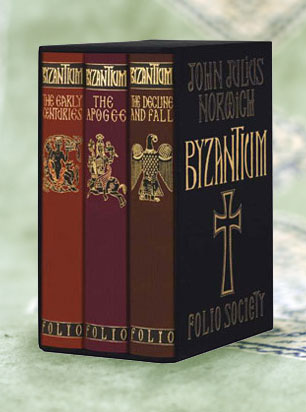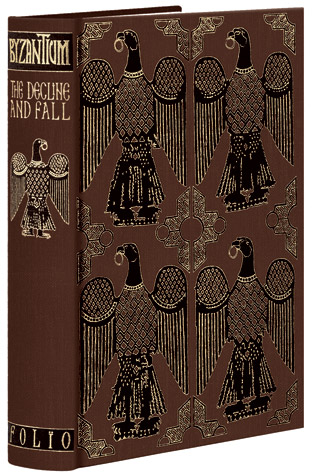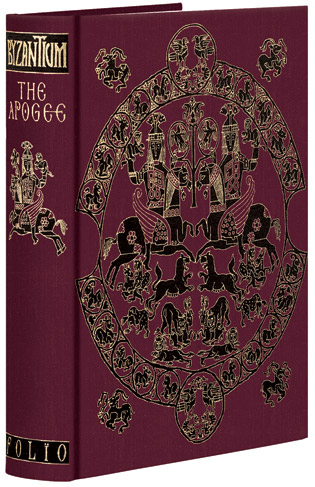Title: Byzantium: The Early Centuries, The Apogee, The Decline and Fall (3 volume set)
Author: John Julius Norwich, Neil Packer (design)
ISBN: –
Publisher: The Folio Society, 2008
Condition: New and perfect. Byzantium is a three volume set presented in a slipcase. Bound in full cloth, blocked with individual front and spine designs by Neil Packer. Set in Monotype Garamond. 75 pages of colour plates. 1,480 pages, Book size: 10″ x 6¾”.
John Julius Norwich’s classic history of Byzantium tells the epic story in all its lurid, magnificent and compelling detail in three magnificent volumes: The Early Centuries, The Apogee and The Decline and Fall.
‘Brilliant . . . he writes like the most cultivated modern diplomat attached by a freak of time to the Byzantine court, with intimate knowledge, tactful judgement and a consciousness of the surviving monuments’
INDEPENDENT
When Constantine the Great gained control of the ailing Roman Empire in AD 323, he proclaimed his new capital would be built on the site of the ancient Greek city of Byzantium. Protected by the narrow straits of the Bosphorus, on the cusp between Europe and Asia, it was ideally situated to rule Constantine’s Eastern dominions. A dazzling vision in gold, porphyry and marble rose up, an architectural splendour surpassing even Rome itself and the heart of an empire that, remarkably, would endure for 1,000 years.
‘Lord Norwich has appeared as a silver-tongued Virgil to guide us’
SUNDAY TIMES
The Early Centuries
Constantinople was always a focus for conflict, insurrection and intrigue. Besieged by the Persians and the Avars in 626, and the Caliph’s fearsome Islamic forces in 674-8 and 717, the city began to inspire legends about its impregnability, and was said to receive divine protection. Inside the massive walls popular factions struggled for supremacy, eunuchs schemed, and unpopular rulers met terrible ends. The two Emperors that prospered most brought untold glory and wealth to Byzantium. Justinian I (527-65), temporary liberator of Italy from the Goths and codifier of the law, built the magnificent church of St. Sophia in the capital. Heraclius (610-41), ‘the First Crusader’, reclaimed the True Cross from the defeated Persians, and made Greek, rather than Latin, the official language of the Empire.
This last action of Heraclius epitomised the cultural and spiritual divisions between Byzantium and the West, and the rift deepened with the fierce theological disputes of the 7th and 8th centuries and the imprisonment of Pope Martin I by the Byzantine Emperor Constans II. In appealing to the Franks for military support, the Papacy showed where its loyalties lay, symbolised by its coronation in 800 of Charlemagne as a rival Western Christian Emperor.
The Apogee
In the early hours of Christmas Day, 820, on the orders of a bitter rival, the Byzantine Emperor Leo V was beheaded in the pews of St. Sophia, his corpse thrown into a common privy and his sons castrated. The Byzantine court was steeped in blood, as ambitious Regents, army generals and brooding siblings vied for the diadem. Yet in spite of such internal strife, during this period Byzantium enjoyed a golden age of Empire. The campaigns of John Tzimisces (969-976) and the ‘Bulgar-Slayer’ Basil II (976-1025) brought the greater part of the Holy Land and the whole of the Balkan peninsula under Byzantine rule.
Two events – one an unmitigated catastrophe, the other an almost inevitable consequence of the widening gap between East and West – came as shattering blows. In 1071, a Byzantine army led by the Emperor Romanus IV Diogenes was routed at the Battle of Manzikert by a new Muslim foe, the Seljuk Turks; and the Great Schism of 1054, the culmination of centuries of feuding, saw Constantinople split from the Church of Rome over the issues of the Trinity, the Latin liturgy and Papal supremacy.
The Decline and Fall
After nearly 900 years, Constantinople fell to a foreign invader for the first time in 1204. The brutal sack was all the more devastating for being perpetrated by the Christians of the Fourth Crusade, led by the blind and elderly Doge of Venice, Enrico Dandolo. Byzantium was carved up by the Venetians, Franks and Normans, with Latin rule imposed at Constantinople and Latin rites in the churches. Greek power was not restored until 1261.
The Latin interregnum crippled the Empire’s administration, economy and shipping, as well as reducing its dominions. The territory it still retained in the mid-14th century was either at the mercy of the rampaging Ottoman Turks and the Serbian Empire, or controlled by the Genoese merchant fleets. The collapse of the east wing of St. Sophia in the earthquake of 1346 and the coming of the Black Death to the capital were powerful symbols of the humiliations to follow, when a succession of Emperors were forced to sell their cities and beg for men and money around the courts of Western Europe. The miracle is that Byzantium survived until 29 May 1453, when the ancient walls were breached by the fanatical warriors of Sultan Mehmet II and Constantinople was finally lost to Christendom.





